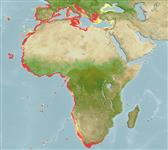Common names from other countries
Пластиножаберные (акулы и скаты) (sharks and rays) >
Rajiformes (Skates and rays) >
Rajidae (Skates)
Etymology: Raja: Latin, raja, -ae = a sting ray (Raja sp.) (Ref. 45335).
More on author: Linnaeus.
Environment: milieu / climate zone / depth range / distribution range
экология
морской; солоноватоводный демерсальный; пределы глубины 17 - 462 m (Ref. 56504), usually 50 - 150 m (Ref. 27121). Subtropical; 44°N - 35°S
Northeast Atlantic: from Spain (Bay of Biscay) to Morocco and Madiera, including the Mediterranean Sea.
Length at first maturity / Size / Вес / Возраст
Maturity: Lm ?, range 44 - ? cm
Max length : 63.0 cm TL самец/пол неопределен; (Ref. 39256); 59.7 cm TL (female); common length : 35.0 cm TL самец/пол неопределен; (Ref. 2683)
Краткое описание
определительные ключи | морфология | морфометрия
колючие лучи спинного плавника (общее число) : 0; колючие лучи анального плавника: 0. Snout short and bluntly pointed; disc angular (Ref. 5578). Upper surface prickly only in young, nearly smooth in adults, underside smooth (Ref. 3167). Upper surface ochre to reddish-brown with scattered dark spots, underside white (Ref. 3167); two bright blue eyespots centered on the pectoral bases (Ref. 5578); may have a small dark spot on tip of snout (Ref. 2708).
Found over soft bottoms of the shelf and the uppermost slope (Ref. 5578). Depth range from 17-300 m, and up to depth of 462 m in the eastern Ionian Sea (Ref. 56504). Feed on all kinds of benthic animals, also on fish offal (Ref. 5578). Oviparous. Distinct pairing with embrace. Young may tend to follow large objects, such as their mother (Ref. 205). Eggs are oblong capsules with stiff pointed horns at the corners deposited in sandy or muddy flats (Ref. 205). Egg capsules are 4.2-4.6 cm long and 2.7-2.9 cm wide (Ref. 41250). About 40-72 eggs are lain by an individual in a year (Ref. 41250). Caught by ski-boat anglers (Ref. 5578).
Oviparous, paired eggs are laid. Embryos feed solely on yolk (Ref. 50449). With egg-cases laid from spring to summer (Ref. 3167). Distinct pairing with embrace. Young may tend to follow large objects, such as their mother (Ref. 205).
McEachran, J.D. and K.A. Dunn, 1998. Phylogenetic analysis of skates, a morphologically conservative clade of elasmobranchs (Chondrichthyes: Rajidae). Copeia 1998(2):271-290. (Ref. 27314)
Статус Красного Списка МСОП (Ref. 130435)
CITES (Ref. 128078)
Not Evaluated
Угроза для людей
Harmless
Использование человеком
рыболовство: коммерческий; объект спортивного рыболовства: да
дополнительная информация
инструменты
Специальные отчеты
Скачать в формате XML
ресурсы в Интернет
Estimates based on models
Preferred temperature (Ref.
115969): 13.1 - 25.6, mean 17.6 (based on 383 cells).
Phylogenetic diversity index (Ref.
82804): PD
50 = 0.5000 [Uniqueness, from 0.5 = low to 2.0 = high].
Bayesian length-weight: a=0.00182 (0.00152 - 0.00218), b=3.27 (3.23 - 3.31), in cm Total Length, based on LWR estimates for this species (Ref.
93245).
Trophic level (Ref.
69278): 3.7 ±0.6 se; based on diet studies.
устойчивость к внешним воздействиям (Ref.
120179): низкий, минимальное время удвоения популяции 4.5-14 лет (Fec assumed to be <100).
Fishing Vulnerability (Ref.
59153): Moderate to high vulnerability (51 of 100).
